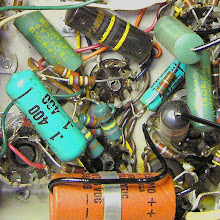Removing components and solder from tube socket tabs is not difficult. But it's a tedious business. If you're removing a lot of components you'll be glad for anything that speeds the process up. Here's a standard solder sucker or solder pump:

It's a common tool used to suck molten solder away from a solder joint. It's spring loaded inside. After it's cocked, pushing the black button releases the internal plunger and causes a vacuum effect at the tip to suck solder away into the body of the pump. It works well in plenty of situations but frequently the flat tip doesn't quite fit the bill. I keep a collection of desoldering tools suited for specific jobs (here's another one I modified for use for PC board mounted pots). On this one I've cut away part of the tip for use at tricky angles. Here's the stock tip and the angled one:


The angled tip is hugely helpful for getting a good seal against the old solder joint on a tube socket terminal. Here it is pressed against one side of the solder joint with the soldering iron heating the joint from the other side:

Note the angle of the tip. In tight quarters it's impossible to get a straight tip to sit this snugly against the tube socket tab. With a nice tight seal against the joint the terminal comes clean with just one activation of the pump:

This may seem trivial, but when you have enough joints to do it saves serious amounts of time. There are around 50 joints for me to desolder and clean on this Ampex 601 rebuild. Futzing around with awkward positioning of the desoldering pump makes for a poor seal and it can easily take a half dozen shots to clean the joint out well in a cramped chassis. If you fiddle with each joint for 2 or 3 minutes you could be spending a couple hours just sucking the solder out. Getting the remaining wires and component leads off of the terminals without damaging them can still be fiddly. But having the old solder removed quickly speeds the process up immensely and gets you on to the interesting parts of the work.




No comments:
Post a Comment